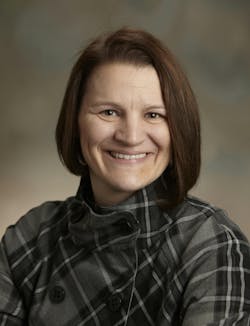Data Center Intelligence: Nicole Dierksheide, Rehlko
The Data Center Frontier Executive Roundtable features insights from industry executives with lengthy experience in the data center industry.
Here’s a look at the Q2 2025 insights from Nicole Dierksheide, Global Category Director for Large Power for Rehlko.
Nicole Dierksheide is the global category leader for Rehlko’s Data Center product line. She has broad experience over her 25+ year career that spans from engineering subsystems on locomotives to marketing test and measurement equipment. Nicole holds a degree in electrical engineering from the University of Arizona and uses her technical expertise to work with customers on finding the optimal solution for their needs. She is a sustainability champion at Rehlko and passionate about driving greener actions both at work and in her personal life.
AI Is Reshaping Infrastructure: How Are You Responding?
Data Center Frontier: How is your organization adapting to the infrastructure demands of AI? As artificial intelligence continues to redefine the design priorities for power, cooling, and site architecture, what specific innovations or strategic adaptations has your company implemented over the past year to meet the performance and deployment requirements of next-generation AI workloads?
Nicole Dierksheide, Rehlko: One of the biggest shifts we're seeing with AI infrastructure is how it impacts power consumption and load behavior. In particular, how AI servers draw power from the grid or backup systems. Traditionally, in most backup power scenarios, like a facility supported by diesel generators, loads are relatively steady. If power is lost, generators kick in and carry the load in phases: 25%, 50%, then 100%. The load behavior is typically predictable and step-based.
With AI, however, we're seeing what's known as microloading. AI servers constantly fluctuate their power demands, often in milliseconds. These are small but rapid changes that don't add up to a full load step, like going from 0 to 3 megawatts, but they still cause the generator to respond. As these micro-loads ramp up or down, the generator's alternator must adjust quickly to maintain proper speed and voltage, similar to how a car engine reacts to acceleration and deceleration.
These rapid fluctuations can challenge the generator’s ability to maintain stable output and power quality. That's where our focus has shifted at Rehlko. We ensure our generators have advanced voltage regulation and fast-reacting control systems that can handle these unpredictable, high-frequency changes in load. Our goal is to deliver consistent, reliable power to the data center even as AI workloads continue to evolve and put new demands on infrastructure.
Speed to Market Is a Competitive Edge: What’s Your Playbook?
Data Center Frontier: What strategies are helping you deliver infrastructure at speed without sacrificing resiliency? With timelines for data center delivery compressing across both hyperscale and edge environments, what proven approaches - whether in engineering, supply chain management, or partner collaboration - are enabling your organization to accelerate deployment while maintaining reliability, efficiency, and sustainability?
Nicole Dierksheide, Rehlko: We all know that the data center market is scaling at an unprecedented rate, and as a backup power provider, we're a key part of the total solution. One of our strengths has always been our ability to support both standard and custom generator configurations. Our standard product lineup — like our popular 3-megawatt genset — is highly configurable using internal tools that allow customers to select from a range of options, such as alternator size or enclosure types. These tools streamline the process and provide fast access to pricing and bill of materials, which is essential for quick deployment.
However, data center projects often require more than off-the-shelf solutions. Heat rejection, airflow challenges, and unique site conditions, like high altitudes or extreme climates, can require modifications to standard equipment. For instance, a site might need an oversized alternator for better airflow, or a configuration that accommodates stacked generators and additional piping. These types of customizations fall into what we call engineering specials, something we’ve long supported across our business.
To meet the speed and complexity of today’s data center demands, we've created dedicated teams focused solely on the data center segment. These teams include engineering, project management, and customer support resources who work directly with hyperscale and colocation customers throughout the lifecycle — from initial design through commissioning and beyond. This close collaboration helps ensure we meet all technical requirements while also staying on schedule.
We've also leaned heavily into digital transformation. We’re integrating digital tools and automation into our engineering and project workflows — not just in the products we deliver, but in how we operate internally. As the industry continues to grow rapidly, we know we can’t simply scale headcount at the same pace. So we're investing in AI and digital platforms to help us manage complexity, improve speed to market, and maintain the reliability and power quality our customers expect.
Standardization vs. Customization: What’s the Right Balance Now?
Data Center Frontier: How are you balancing standardization with client-specific customization in 2025? Given the dual pressures of rapid scaling and the unique demands of AI and hybrid workloads, how is your team navigating the trade-offs between delivering standardized infrastructure and meeting bespoke customer needs? Where do you see flexibility delivering the most value today?
Nicole Dierksheide, Rehlko: We’ve found that the best outcomes come from building long-term partnerships with our customers. When we have a continuous relationship, we gain valuable insight into their evolving needs. For example, we work with one major customer who initially required a specialized solution. Over time, as we've delivered between 70 and 105 units per year for them, that engineering special has essentially become a repeatable, standardized build. The initial customization goes through its testing and approvals, but once it’s validated, it transitions into a consistent, scalable offering. It’s not truly off-the-shelf, but it’s no longer a one-off either.
This hybrid approach, where a unique customer need becomes a standardized product for them, strikes the right balance. It allows us to move faster while still addressing site-specific or application-specific requirements. That’s especially valuable in the AI space, where power density is increasing rapidly. A standard rack used to draw around 30 kW; now, AI racks can demand upwards of 70 kW or more. That significantly shifts backup power requirements.
For instance, if a customer previously needed 50 three-megawatt generators to support their data center, they might now need 60 to support the same footprint with AI-driven workloads. Or they might consider moving up to four-megawatt gensets to keep pace. Fortunately, we offer that scalability, and our customers can adapt their infrastructure accordingly.
Flexibility delivers the most value when it's paired with repeatability. Once we’ve aligned on a design and gone through that initial "first-of-a-kind" phase, the solution becomes familiar and efficient to produce. This reduces lead times, increases consistency, and ultimately helps our customers scale more quickly without sacrificing reliability.
What Does True Data Center Industry Innovation Look Like in 2025?
Data Center Frontier: What does meaningful innovation in the data center sector look like right now? In a marketplace crowded with bold claims and emerging technologies, how do you separate marketing noise from truly transformative innovation? And what is one underappreciated technical or strategic breakthrough your organization believes will materially influence data center development over the next 12 to 18 months?
Nicole Dierksheide, Rehlko: There’s no shortage of buzz around emerging technologies, such as hydrogen fuel cells, nuclear microreactors, and large-scale battery storage, to name a few. These are exciting developments with long-term potential, but many are still in the pilot phase. What’s often overlooked is that while every technology comes with benefits, it also comes with trade-offs. Diesel gensets, by contrast, have been around for over a century. We not only understand the pros and cons, but we’ve also engineered systems around those realities. The infrastructure, standards, and support are already fully developed, making diesel a proven, reliable solution in the near term.
In the next 12 to 18 months, we see the most impact coming not from disruptive tech, but from practical, sustainability-focused improvements to existing systems. One example is HVO (hydrotreated vegetable oil), which can significantly reduce fuel lifecycle emissions without modifying existing engines. We’ve already transitioned our facility in Brest, France, to HVO and are working toward similar efforts in North America as supply improves.
We’re also looking at other ways to reduce environmental impact, like using waste heat in place of electric block heaters, and we’ve built internal tools to calculate the long-term emissions savings of such changes.
And I’ll also add that we're proud to be the only generator manufacturer currently offering an Environmental Product Declaration (EPD), known as the PEP ecopassport, for our KD Series gensets. The PEP ecopassport gives data centers a transparent view of the carbon impact across manufacturing, operation, and end-of-life, helping them make more informed, sustainability-aligned decisions.
Ultimately, the most transformative progress — at least in the near term — comes from optimizing proven technologies to meet new demands in smarter, more sustainable ways.
About the Author
Matt Vincent
A B2B technology journalist and editor with more than two decades of experience, Matt Vincent is Editor in Chief of Data Center Frontier.



